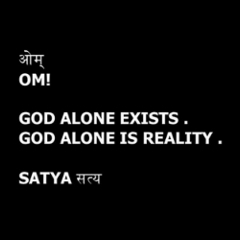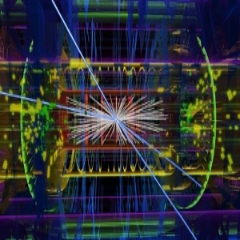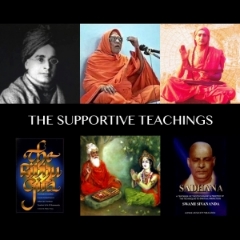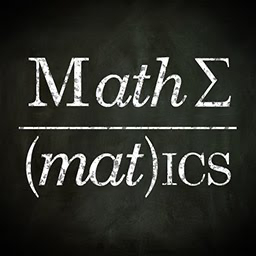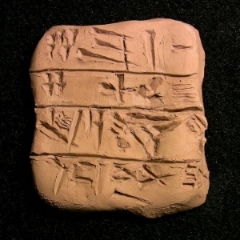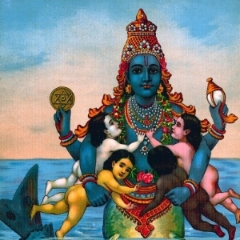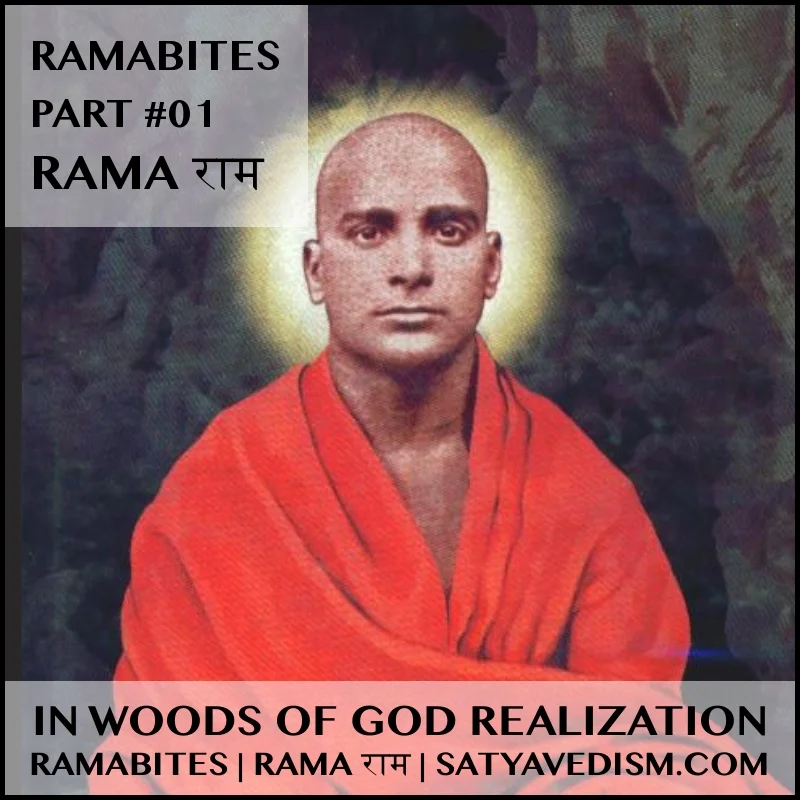KENA UPANISAD | 1.3 & 1.4 | AMOETD
| | homeKENA UPANISAD | 1.3 & 1.4 | SRI ADI SANKARACARYA
KENA UPANISAD | 1.3 | SRI ADI SANKARACARYA
na tatra caksuh gacchati na vak gacchati no manah
na vidmah na vijanimah yatha etat anusisyat || 1.3 ||
3 . The eye does not go there , nor speech , nor mind . We do not know ( Brahman to be such and such ) ; hence we are not aware of an any process of instructing about IT .
|| BHASYA || : Since Brahman , as the Ear etc of the ear etc , is the Self of those organs , therefore , tatra , there , to that Brahman ; caksuh , the eye ; na gacchati , does not go ; for it is not possible to go to oneself .
Similarly , na vak gacchati , speech does not go . When a word , as expressed by the organ of speech , reveals its own idea , speech is said to go to its object .
But Brahman is the Self of that word , as also of the organ that utters it ; therefore speech does not go .
Just as fire , which burns and illumines , does not burn or illumine itself , similarly is this so .
No manah , nor the mind . Though the mind thinks and determines other things , it does not think or determine itself ; for of it , too , Brahman is the Self .
A thing is cognized only by the mind and the senses . As Brahman is not an object of perception to these , therefore , na vidmah , we do not know , " That Brahman is of this kind " .
Hence na vijanimah , we are not aware of ; yatha , the process by which ; etat , this Brahman ; anusisyat , should be taught , instructed to a disciple — this is the significance .
For , a thing that is perceived by the senses can be taught to another through categories denoting class , quality , and action .
Brahman is not possessed of these categories , viz class etc ; hence it is very difficult to convince the disciples about IT through instruction .
In this way the Upanisad shows the necessity of putting forth great effort in the matter of imparting instruction and comprehending its meaning .
The contingency of the total denial of any process of instruction having arisen from the text ,
" We do not know Brahman , and hence we are not aware of any process of instructing about IT "
, an exception to this is being stated in the next verse . True it is that one cannot impart knowledge about the Highest with the help of such means of valid knowledge as the evidence of the senses ; but the knowledge can be produced with the help of traditional authority * .
Therefore traditional authority is being quoted for the sake of imparting instruction about IT :
KENA UPANISAD | 1.4 | SRI ADI SANKARACARYA
Anyat eva tat viditat athah aviditat adhi iti shushruma purvesham ye nah tat vyachachakshire || 1.4 ||
4 . " That ( Brahman ) is surely different from the known ; and again , IT is above the unknown " — such was ( the utterance ) we heard of the ancient ( teachers ) who explained IT to us .
|| BHASYA || : Anyat eva , different indeed ; is tat , that which is the topic under discussion and which has been spoken of as the Ear etc , of the ear etc , and as beyond their reach .
IT is , indeed , different from the known . The known is very much within the grasp of the act of knowing , that which is the object of the verb , " to know " . Inasmuch as everything is known somewhere by somebody , all that is manifested is certainly known . The idea is that , IT ( Brahman ) is different from that .
Lest , in that case , IT should be unknown , the text says , ( IT is , ) atho , again ; different aviditat , from the unknown , from what is opposed to the known , from that which consists of the unmanifested ignorance , which is the seed of the manifested .
The word adhi , used in the sense of " above " , means " different " by a figure of speech ; for it is well-known that anything that exists above another is different from that other . Whatever is known is limited , mortal , and full of misery ; and hence it is to be rejected .
So when it is said that Brahman is different from the known , it amounts to asserting that IT is not to be rejected . Similarly , when it is affirmed that IT is different from the unknown , it amounts to saying that IT is not a thing to be obtained .
It is for the sake of getting an effect , indeed , that somebody different from it acquires some other thing to serve as a cause . For this reason , too , nothing different ( from the Self ) need be acquired to serve any purpose distinct from the knower ( Self ) .
Thus the statement , that Brahman is different from the known and the unknown , having amounted to Brahman being denied as an object to be acquired or rejected , the desire of the disciple to know Brahman ( objectively ) comes to an end , for Brahman is non-different from the Self . ( Or , according to a different reading — the desire of the disciple to know a Brahman different from the Self , comes to an end ) * .
For nothing other than one’s own Self can possibly be different from the known and the unknown .
Thus it follows that the meaning of the sentence is that the Self is Brahman .
And this also follows from such Vedic texts as :
" This Self is Brahman " ( Ma . 2 ; Br . II . v . 19 , IV . iv . 5 ) ,
" that Self which is untouched by sin " ( Ch . VIII . vii . 1 ) ,
" the Brahman that is immediate and direct — the Self that is within all " ( Br . III . iv . 1 ) , etc .
In this way , the text , " Thus we heard " etc , states how through a succession of preceptors and disciples , was derived the purport of the sentence which establishes as Brahman that Self of all which is devoid of all distinguishing features , and is the light of pure consciousness .
Moreover , Brahman is to be known only through such a traditional instruction of preceptors and not through argumentation , nor by study ( or exposition , intelligence , great learning , austerity , sacrifices , etc — iti , such ( was what ) ; susruma , we heard ; purvesam , of the ancient teachers ; the teachers ye , who ; vyacacaksire , explained , taught clearly ; nah , to us ; tat , that Brahman .
The idea that the Self is Brahman having been established through the sentence ,
" That is surely different from the known , and again , that is above the unknown "
, the hearer has this doubt :
" How can the Self be Brahman ? For the Self is familiarly known to be that which is entitled to undertake rites and meditation and which , being subject to birth and death , seeks to attain either the gods headed by Brahma ( Creator ) or heaven by undertaking the practice of rites or meditation .
Therefore some adorable being other than that ( Self ) , eg Visnu , Isvara ( Siva ) , Indra , or Prana ( vital force or Hiranyagarbha ) may well be Brahman , but not so the Self ; for this is opposed to common sense . Just as other logicians say that the Self is different from the Lord , so also the ritualists worship other gods saying ,
' Sacrifice to that one ' , ' Sacrifice to that one ' .
Therefore it is reasonable that , that should be Brahman which is known and adorable ; and the worshipper should be one who is different from this " .
Having noticed this doubt either from the looks or the words of the disciple , the teacher said , " Do not be in doubt thus " ; —
" That which is not uttered by speech , that by which speech is revealed , know that alone to be Brahman , and not what people worship as an object . || 1.5 || "
( NOTE : * The word used by Sankara is agama , which literally means traditional knowledge which has come down through the line of teachers and pupils . By quoting traditional teaching one does not expose oneself to the charge of speaking about something that defies speech . | * The expression concerned is svatmano'nanyatvat brahmavisaya jijnasa , or svatmano'nyabrahmavisaya jijnasa . )
|| UPADESA SAHASRI : A METHOD OF ENLIGHTENING THE DISCIPLE || I.I.6 || COMPLETE AMOETD SERIES ➤➤ | INTRODUCTION ➤➤ ||
|| THIS SCRIPTURE SERIES SOURCE || ➤
|| 1 || http://www.SATYAVEDISM.com ||
|| 2 || http://bit.ly/SRIADISHANKARA ||
http://www.SATYAVEDISM.com/shankara/amoetd/
SOURCE | SATYAVEDISM.ORG











